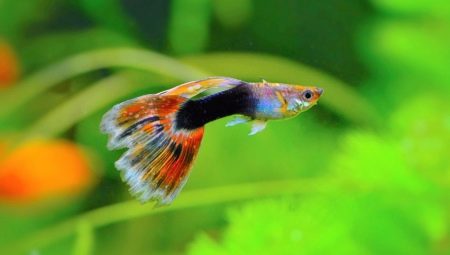Aquarium science is a complex science, but guppies are so widespread aquarium fish that even those who have never dreamed of their own aquarium have heard about them. Unpretentious pets are often chosen by beginners to start, and yet you should get to know them better before you put them in your own pond.
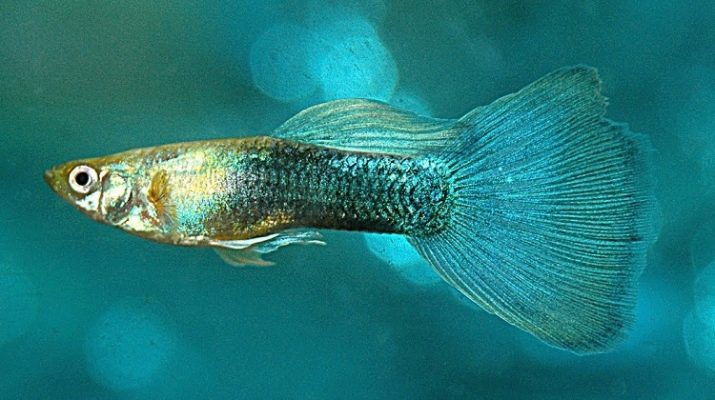
Description
Guppy is rightly considered the least whimsical aquarium fish, because it coexists perfectly in the aquarium in any layer. Homosexual individuals are quite different from each other. The males are noticeably smaller in size (1.5-4 cm in length versus 3-7 cm), but they look much brighter, since the females are usually gray.
Experts note that in captivity, "gupeshki" grow to sizes that they fail to achieve in the wild.
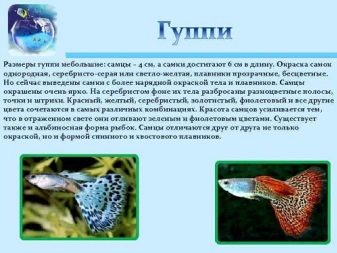
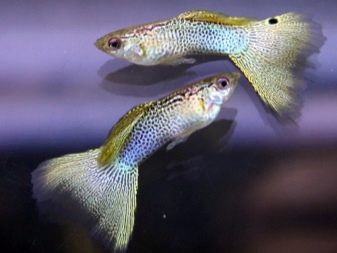
Initially, these fish lived in fresh and brackish water bodies of Venezuela and the adjacent islands of the Caribbean Sea. Scientists have noticed that this living creature reduces the population of the malaria mosquito, as it feeds on its larvae, which grow in the water. This property turned out to be so valuable that the fish were acclimatized in all regions where the water temperature range in rivers and lakes only allows.
In Russia, of course, inappropriate conditions, however, in the Moscow River and the vicinity of some Volga cities there are feral guppy populations.Apparently, once aquarists released it, now it reproduces itself and lives, focusing on the places of discharge of heated wastewater.

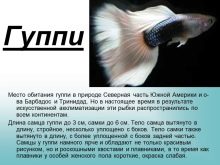
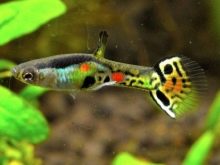
This species got its name in honor of the British priest Robert John Lechmer Guppy, combining soul-saving activity with scientific. It was he who, in 1886, made a report to the Royal Society and reported on a fish that does not spawn like its relatives, and gives birth to living babies. Contrary to popular belief that science was already quite advanced at the end of the century before last, pundits made Guppy laugh at such statements. Only a little later, the amazing fact of the existence of viviparous fish was proved.

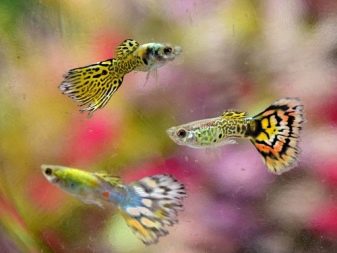
Overview of popular breeds
Contrary to popular belief, caused by the outward diversity of such pets, guppies are one species, not several. Species are called breeds, that is, they do not occur in the wild, but are the result of purposeful selection by a person to obtain special characteristics, which in most cases are a color change. In order to breed a new breed, professional breeders start from a limited group of individuals with interesting features, and sometimes the basis for a new subspecies becomes a completely unique one.
It should be noted that the hallmarks of a new breed are usually considered color (mainly for males, because the females are dim), body shape and size, as well as the tone of the fins. The predominant part of the breed is called by color, but most often the name is given not by the shade of the body, but by the color of the tail. This criterion allows you to highlight white, gold, red, blue, silver and other guppies.
An alternative classification is guided in the selection of names by the shape of the caudal fin. Here, the names also speak for themselves, fan-tailed, voile-tailed, shovel-tailed, lyre-tailed and other fish species stand out.
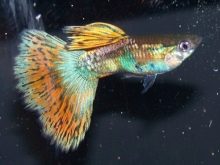

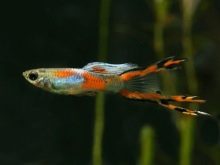
Life span
Most aquarists who have decided to add these beautiful little fish to their home pond are interested in how long the lifespan of representatives of this species is. There is no definite answer, since a lot depends on the features of the content. It is generally accepted that the average gupeshka lives about 2 yearsbut if for a male 3 years is considered a “ceiling”, then a female can live even four. It is noted that in the aquarium, on average, the fish lives a little longer than in nature.
This unpretentious living creature feels best at water temperature in the range of 22-25 ° C. At home, the temperature may turn out to be higher, especially if the "wise" beginner decides that such a warming is useful for a tropical guppy, and he will be mistaken in this.
With excessive heating, the fish does not feel worse, however, its metabolism accelerates in its body, which means that the pet will age faster than expected.
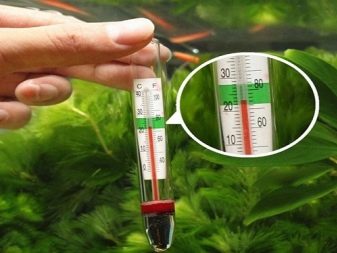
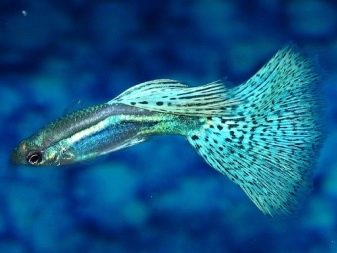
Having learned about this feature, many inexperienced aquarists fall into the opposite extreme, they begin to keep their darling in the most cool water, knowing that even 19 ° C is not a problem for the gupeshka. If you never lower the temperature below the specified one, then this approach may still be appropriate. But it is important to know the measure, because the fish will still not become immortal, and with your excessive zeal you can catch the poor thing.
The experience of aquarists with experience also suggests that in solitude the fish "sad" and lives on average less than in the company of their own kind.
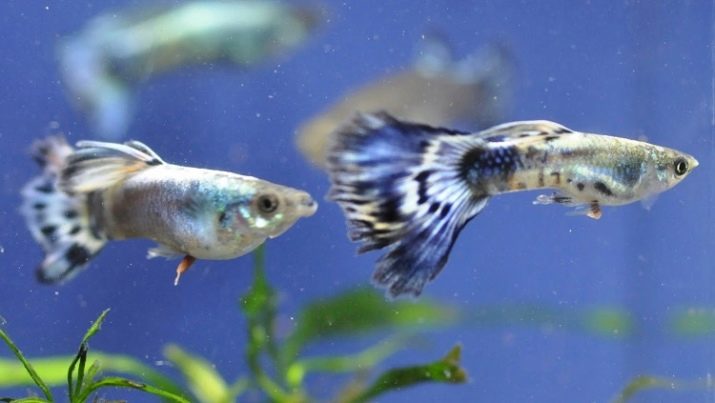
Content Features
Guppy is an unpretentious pet, but this common truth often goes to the detriment of the fish, as some owners believe that it can be kept almost in a bank. For the pet you need to create certain conditions without which she will die immediately or simply will not live long, and to achieve the required conditions will be easy.
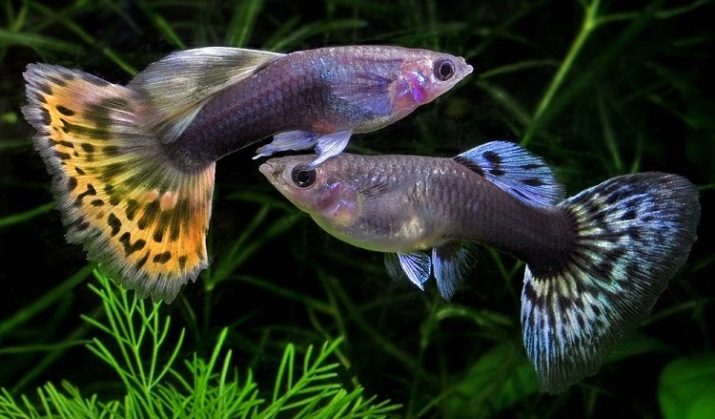
Aquarium volume
Start by acquiring a suitable aquarium. You should know that this species is characterized by increased activity and its representatives like to "drive" across the territory. With all the modesty of body size guppies in a capacity of 20 l can hold no more than three individuals. If the capacity is large enough and there is enough space, then as many as 300 males or 100-150 females can be settled in 100 liters of water.
It should be borne in mind that babies are prone to very fast breeding, and therefore only 2-3 males are usually isolated for 2-3 females, even if the color of the aquarium decreases from this.
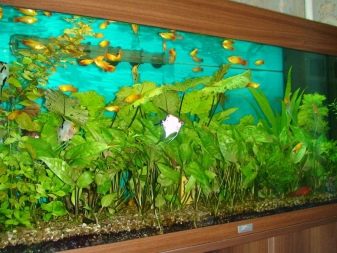
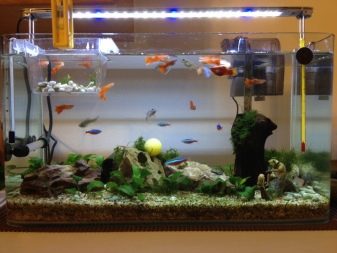
Water characteristics
In theory, guppies feel fine in water at a temperature of 19-29 ° C degrees, but the optimal range is 22-25 ° C, as already mentioned. Sharp changes should not be allowed even within the limits of the declared norm, as this will adversely affect the health of the fins in males. The same applies to other key parameters, which include stiffness (optimally - 10-12 ° W) and pH (6.5-8.5).
Given the unfavorable reaction of pets to sudden changes, experts advise more frequent water changes so that the mass of the replaced fluid is less. You can replace no more than a third of the volume at a time, and you need to do this weekly.
You may not immediately understand that the characteristics of the water have changed, but the fish simply cannot help but feel this. To check the condition, you should buy special tests sold in pet stores, and experienced owners simply grow Indian fern in the aquarium. It grows normally in the near-bottom area in water suitable for guppies, but when the basic indicators deteriorate, the roots rot and the plant rises to the surface or even dies. Nonetheless, the rule of refusal of sudden changes in the characteristics of water is valid in any case.
Even if the liquid is no good, drastically changing the entire volume is unacceptable.
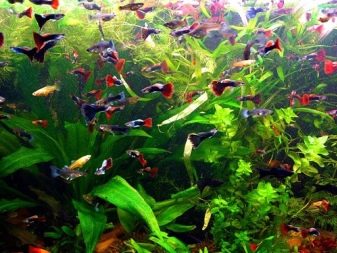
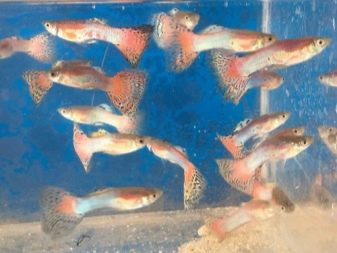
It is curious that gupeshki love salt. Experienced aquarists are advised to add a tablespoon (no slide!) per 10 liters of water. When changing water, the amount of salt is calculated based on the added volume of liquid, and not the entire aquarium.
These tropical fish do not like strong currents, so when choosing filters, you should give preference to scattering the output stream. It is desirable to illuminate the water depths with light of moderate strength, the duration can reach 12 hours a day.
Aeration causes certain disputes. On the one hand, guppies are good because they sometimes survive even without it, on the other hand, why do you need to have pets so that they suffer. In any case, these fish cannot live completely without oxygen, and if your aquarium is equipped with a tight cover that blocks the natural contact of the water surface with the atmosphere, then an aerator or filter with the oxygen saturation function is mandatory.
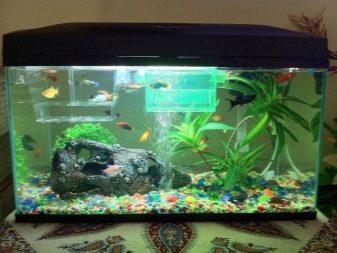
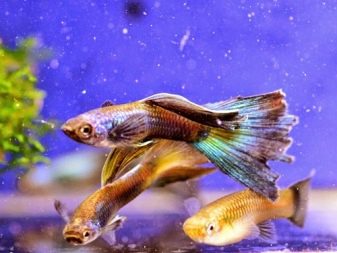
Compatible with other fish
Experienced aquarists prefer to maintain a whole underwater world with biological diversity. "Gupeshki" in this regard are very good, because they are non-conflict and ready to share living space with other fish. But their peaceability does not combine well with the aggression of predatory species, which, if size allows, will enjoy their smaller cousins with pleasure.
With this in mind, it is necessary to select the inhabitants of the aquarium so that the guppies do not encounter predators, and, if possible, with larger peaceful fish.
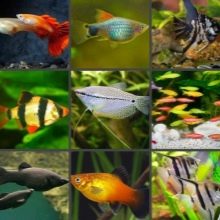
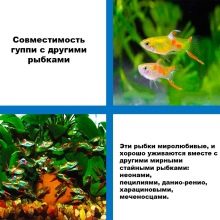
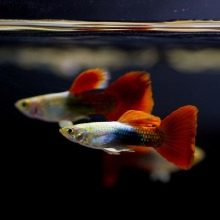
Food
In terms of nutrition, these pets belong to the category of gourmets. They feel better when using different types of feed. Dry mixes should alternate with live food, such as daphnia or bloodworm.
Specialists pay special attention to the fact that breeds bred by breeding in most cases have reduced adaptive abilities, therefore they should be handled with particular care, avoiding any deviations from ideal conditions.
Extremes can be considered albinism and excessively dark pigmentation, it is precisely such "gupeshki" that will die first.
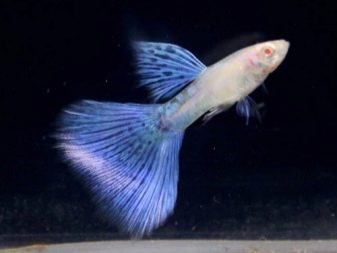

The differences between male and female
Being able to distinguish a male from a female is a key skill for an aquarist who has decided to breed guppies. It is necessary at least in order to correctly calculate the amount of water per population, and for pairing it is also a useful skill. Usually, differences are observed in representatives of different sexes already starting from a weekly age. It is clear that with small sizes of fry and even in motion it is not so easy to understand who is who, but you can study them through a magnifying glass.
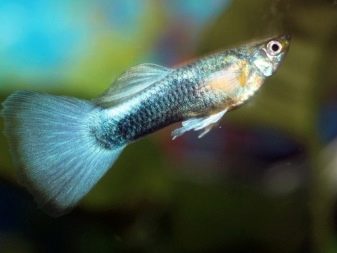
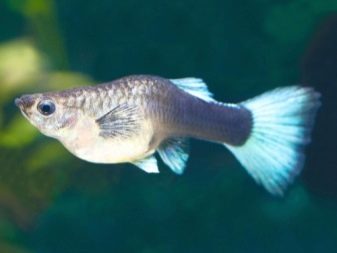
Body shape
The female carries not just caviar, but full-fledged living fry, because even during the absence of pregnancy, it has a well-defined abdomen, which in the "interesting position" increases even more and makes the fish look like a small barrel.
The male is on average shorter than his girlfriend and is distinguished by indicative harmony.
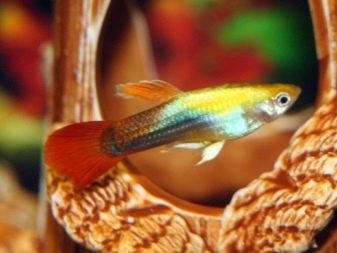

Body size
If you are sure that individuals of a purely one breed are represented in your population, you can and should be guided precisely by the dimensions. The male has the simplest tasks: to convey the genetic material to the female and quickly swim away from the enemies. therefore it is nimble and small, the average length is 3 cm.
Female representatives should bear babies, for this a certain place is provided in their body, and the length of the female is able to reach clearly visible 6 cm. If all the pets really belong to the same breed, you can not use the ruler, the "gupeshki" may be smaller than the declared sizes, but the difference in the dimensions of the heterosexual individuals will be obvious
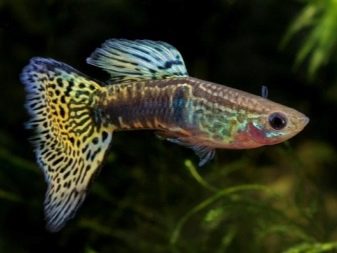
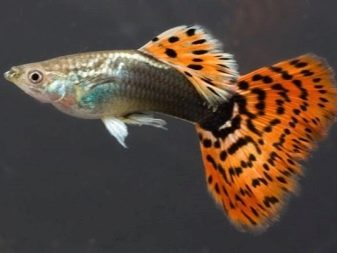
Color
In the wild, it is the male who must conquer the female with his appearance, because the guppy boy impresses his girlfriends with bright coloring, plain, mottled or striped. But people who want to add as much color to their aquarium as possible have worked for decades to bring out beautiful females. For this reason, the color does not always allow you to determine the sex of the fish accurately, it can only confirm the conclusions made on other grounds.
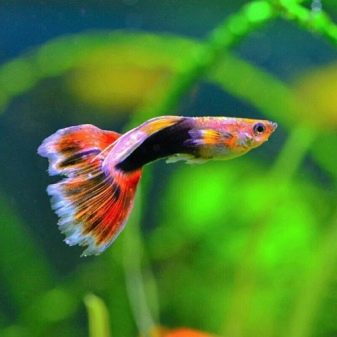
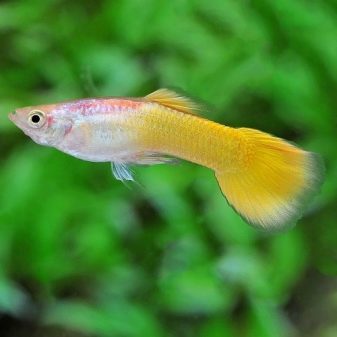
"Spot of Pregnancy"
In females, the place where she carries the fry looks like a speck of a different color, located below the abdomen closer to the tail, and is clearly visible. During the gestation of fry, it gradually darkens, and in later stages you can even directly observe unborn babies.
But even in the interval between pregnancies, the spot, albeit a brightened one, does not disappear.
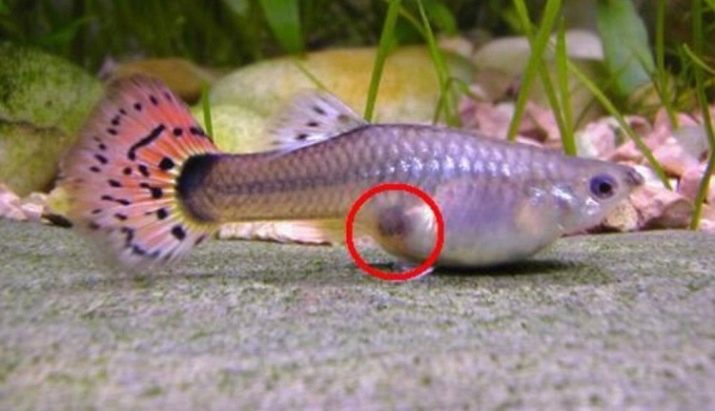
Dorsal fin structure
As mentioned above, the male, for the sake of success, must be handsome, and therefore his dorsal fin is distinguished by a relatively large length. This is especially noticeable when the guppy moves at high speed, the fin, as it were, ripples, not keeping up with its master.
Females also have such an organ, but it is relatively short, therefore, a similar effect is not observed.


Tail fin features
The male is usually clearly visible due to the bright and magnificent tail, which, as a rule, has an interesting shape or increased length. The female is much more modest in this regard, her tail is narrow, short and faded.
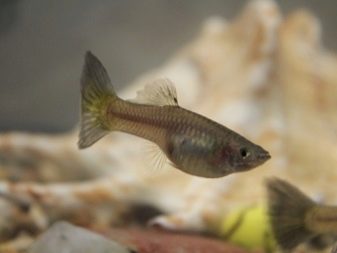
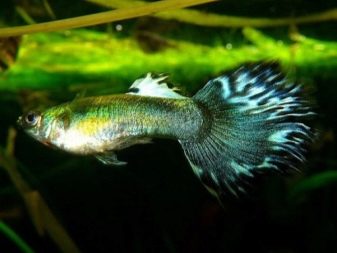
Anal fin
On the lower side of the guppy's body there is another fin, which also allows you to distinguish gender. In the female, he is not remarkable for anything, it’s just a comparatively short triangular fin fin, near which the above-mentioned “pregnancy spot” should be revealed. In the male, this organ performs an interesting function - it replaces the penis with the "goupeca". The fin has a typical phallic shape, is elongated in length and relatively narrow, while its tip is characterized by slight pointedness.
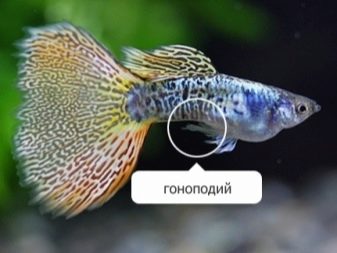
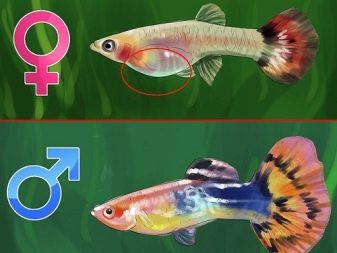
Propagation Features
Guppies are easy to keep at home not only because they are easy to care for, but also because of increased activity in the field of self-healing of the population. In the desire to reproduce, these fish are often compared with rabbits, in connection with which many aquarists consciously acquire a capacity of a volume larger than they should for the available number of individuals.
Guppies are of great interest for the reason that belong to live-bearing fish. You will never see eggs from them, since such simply does not exist in nature. At the same time, fry, only hatching, are at great risk: their parents, peace-loving in relation to any other species of fish, are prone to cannibalism and can gobble up their own young if not timely resettled.
Another curious feature of this miracle of nature is that a female guppy, fertilized once, is able to produce offspring several times in the future without re-fertilization.
For this reason, the breeder must very reasonably calculate the volume of the aquarium, otherwise the youth will simply have nowhere to settle.
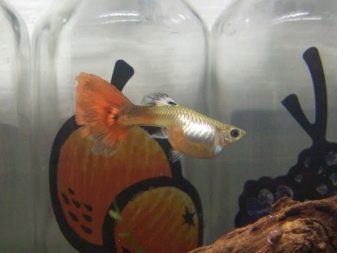
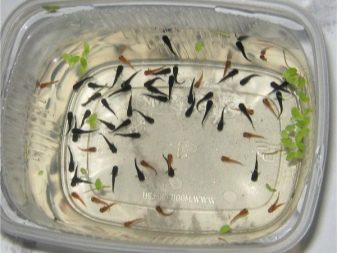
Breeding
Guppy puberty occurs at the age of about 4-5 months. Before this period, pregnancy is unlikely, but immediately after the onset of maturity, a healthy pet will probably take advantage of her ability and become pregnant in the shortest possible time. The owner’s task is to track the status of their pets, because a pregnant woman should be put in a separate aquarium. It is possible to determine its new status due to the fact that the "spot of pregnancy" has darkened, and the nearby anal opening has acquired a red tint and swollen.
After identifying a pregnant woman, select a separate temporary place of residence for her. A large volume is not required, a small aquarium of 5 liters will fit as a spawning ground, an alternative can be a plastic basin of the same volume or even a simple three-liter bottle.
The owner is required to ensure the sanitary cleanliness of the container before planting a potential woman in labor.
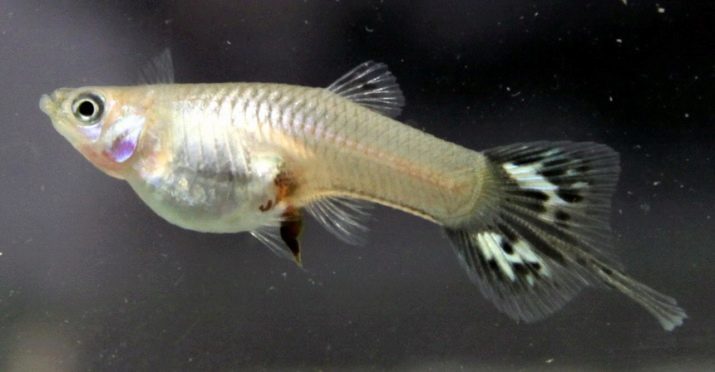
Ideally, of course, you need to create conditions similar to those in the aquarium, it is advisable not to change the main characteristics of the water, but the temperature can be increased to 26-27 ° C. Riccia and other dense plants in the spawning area will not interfere, so the fish will feel a little more comfortable. It is difficult to say exactly at what stage the pregnancy of the female is determined, but in general it lasts 5-6 weeks. This period is worth orienting.
If "ordinary" guppies need a variety of food, then A pregnant female is advised to feed exclusively with a bloodworm. This is a very nutritious food, and the future mother will not interfere with her strength. The number of newborns cannot be accurately predicted; it depends on the age of each of the parents and can range from 20-100 fry.
For reasons of potential cannibalism a newly minted mother must be immediately isolated from her own children, as soon as all of them are born. It is not difficult to determine the approximate period, because before birth, the babies are clearly visible in the body of the nursery. Having fulfilled her duty, the mother returns to the general aquarium, while the children do perfectly without her care. They are born in a thin caviar shell, but almost immediately get out of it, stray into a flock and float higher, because it is warmer there.
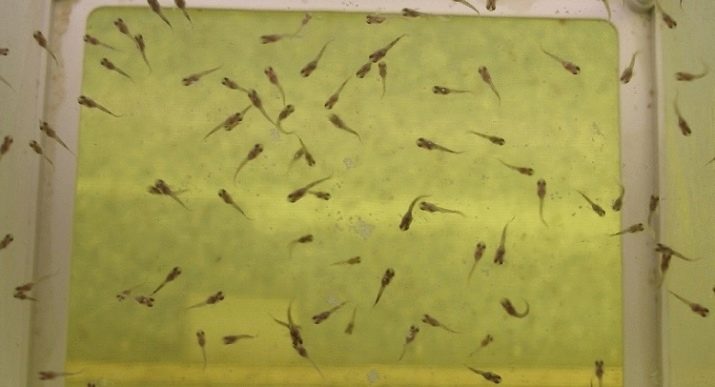
Young people have a great appetite; at the initial stage of their development, they will not refuse to dine 4-5 times a day. At this moment, the ciliator is a virtually non-alternative variant of food for fry. With the growth of young animals, the frequency of feeding is gradually reduced, bringing it to the "adult" standard - twice a day. At the same time, the menu is changing, which gradually includes chopped bloodworms and other foods for adults.
For a pregnant female, special care is not required, but her children should be constantly monitored. Fraternal feelings are uncharacteristic for them, and those who managed to grow faster will regularly push the smaller and weaker ones from the feed, further exacerbating the gap. If you are not interested in natural selection at home, but in productive rearing of young animals, you should sort the youth into groups so that in each of them all members are approximately the same size.
Under standard conditions, insoluble problems usually do not arise, but you should still be prepared for them.It happens that a potential mother, whom it is high time to give birth, cannot do this in any way. Do not panic, because the problem is solved easily. All that’s needed is that replace half of the water in the tank at a time and increase the temperature to 28-29 ° C.
Experienced aquarists claim that this method guarantees success in one hundred percent of cases.
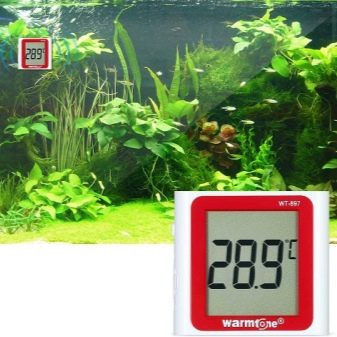

Aquarium decoration
Guppy aquarium design features depend on how the owner is set up. Theoretically, this fish can live in a completely empty aquarium, which is also easier to clean in the absence of soil and plants. But you must admit that it will be more like a commonplace can than a full-fledged corner of the underwater world. Guppies themselves are not averse to having fun among the algae that remind of their homeland, and the whole picture will look more lively.
Plants should not be planted, because with sharp and rapid movements, guppies with their long fins can touch hard leaves and trunks and be injured. For the same reason, it is advised not to decorate the pond with snags and stones, or to select such jewelry as carefully as possible so that they do not have sharp edges. Breeding varieties of fish with long fins are much more likely to receive injuries, and therefore, the interior for them must be chosen carefully.
As a soil usually use simplest gravel. It is rounded and does not create gaps in which the fish could be stuck. From plants it is advised to plant Indian fern, floating ricchia, Canadian elodea and other similar freshwater species.
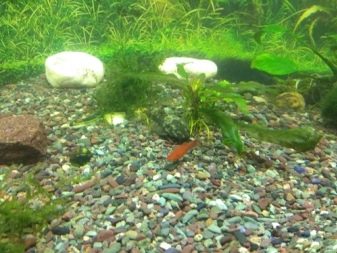
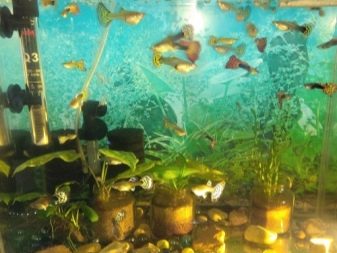
Possible problems
Although guppy is considered one of the simplest fish in terms of keeping, it, of course, can also get sick and die. This disease is characterized by all diseases that are considered typical of tropical aquarium fish. In many cases it would be wiser not to bring the situation to critical, but to carry out preventive measures in a timely manner, but if a misfortune happened, you need to understand what to do.
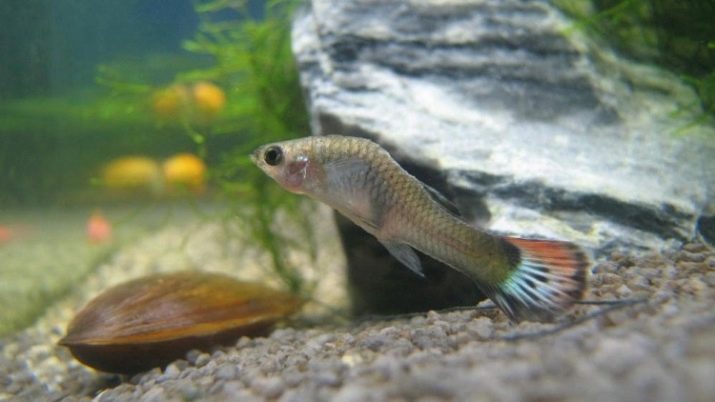
Tail destruction
Among the most common include problems with the tails, which are split and destroyed. This not only spoils the appearance of the fish, but also directly indicates that something is wrong with it, because in some cases part of the body can “disappear” completely. The owner must understand what the reason is and eliminate it as soon as possible, otherwise the situation may worsen.
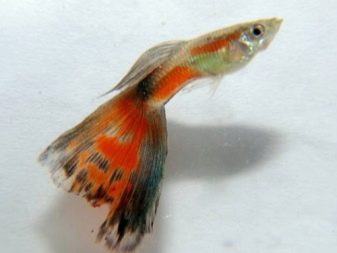
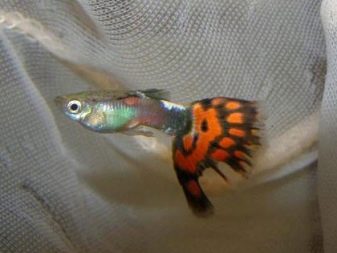
The reasons themselves are usually as follows.
- Stagnant water. Periodic water changes are necessary because the fish have nowhere to go to the toilet, and as they pollute the surrounding fluid, they live in their own increasingly concentrated sewage. Naturally, the body annoys itself that it cannot be used to any advantage (nitrates and ammonia), and these same substances, falling back, provoke poisoning with the possible destruction of the caudal fin. Affected individuals may not restore their original appearance, but to prevent this from happening, you must not ignore the timely substitution.
- Large-scale water change. Guppies do not accept a sharp change in conditions, and it is difficult to select a liquid with completely identical hardness and acidity. Do not even think of relying on the stability of the water supply system, maybe you do not feel it, but it constantly gives different water, therefore it needs to be replaced in the aquarium gradually and little by little.
- Avitaminosis. Fishes, like humans, may lack vitamins. This is especially noticeable in males who, due to vitamin deficiency, lose their pigmentation brightness. In addition, their fins become brittle and sometimes seem to break at all for no apparent reason.
- Injuries. Guppies do not get into a fight, but this does not mean that the other inhabitants of the aquarium are equally peaceful. In addition, you can injure the tail and accidentally, catching it with an object in the aquarium. The latter situation is typical of those species of fish that are distinguished by particularly long tails.
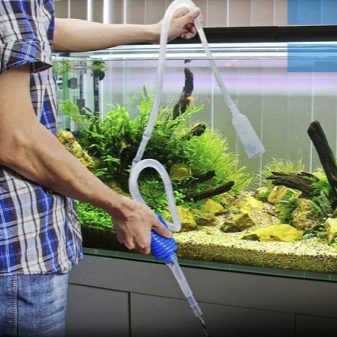

If there is no tail left, then the situation is even more dangerous. This speaks either of the excessive aggressiveness of the neighbors, when the problem is solved only by the resettlement method, or of infection. With similar symptoms, tail fin adhesion is possible, but it is important to understand what’s the matter, because infection often involves the destruction of sick pets, followed by disinfection of the aquarium and all aquarium equipment.
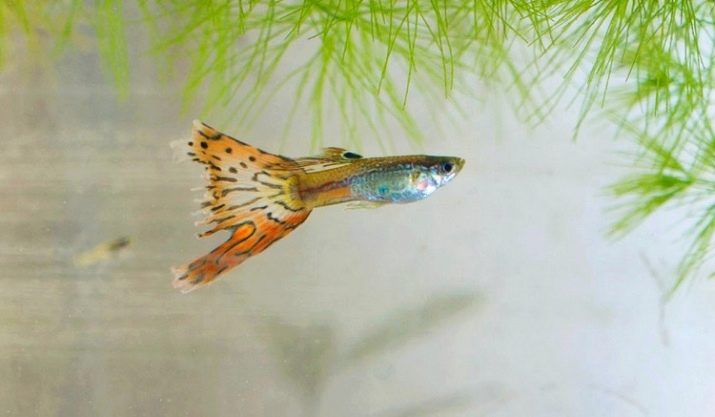
Hump formation
A curved spine is also quite common, and it can be either a variant of the norm or a sign of pathology. For "oldies" this is normal, but for adult "gupeshki", curvature can occur due to excessive overpopulation of the reservoir. The real problem arises if young individuals become hunchbacked, as this can be microbacteriosis or tuberculosis.
Treatment is theoretically possible, but it is very complicated and does not guarantee a positive outcome, and tuberculosis is contagious, therefore patients should be immediately isolated.
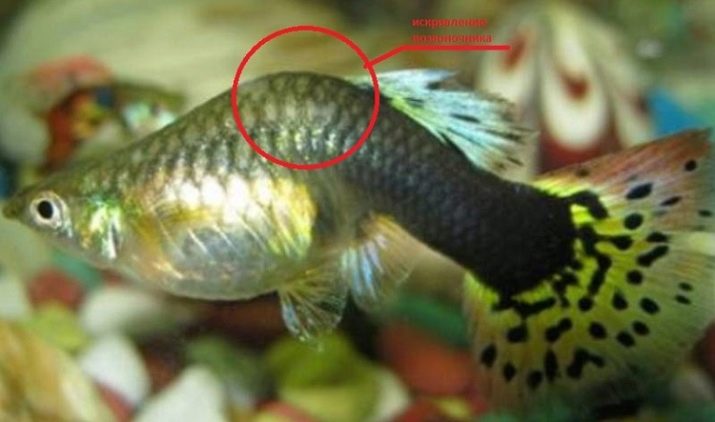
Oxygen starvation
If guppies swim at the surface of the water, and not over its entire thickness, this usually indicates that there is not enough oxygen in the aquarium. The reasons for this can be very different:
- excessive heat;
- prolonged lack of cleaning the aquarium of waste;
- irregular water changes;
- excessive population density in capacity.
In especially advanced cases, the fish swims vertically, head up and tail down. In addition, too dirty and stagnant water provokes the guppies to jump upwards, because of which they can completely leave the aquarium, therefore containers with them are often covered with lids. True, the jumps are often caused simply by the excessive activity of the goupies.
If you suspect your own omissions to leave, replace part of the water immediately, but do not overdo it so that the characteristics do not change much. Replace the aquarium too tight with a larger one or simply move some of the inhabitants to another tank. Alternatively, the filter or aerator needs to be moved closer to the surface of the water and turned on in enhanced mode if adjustment is possible. These measures will allow to saturate the liquid with oxygen and remove excess waste.
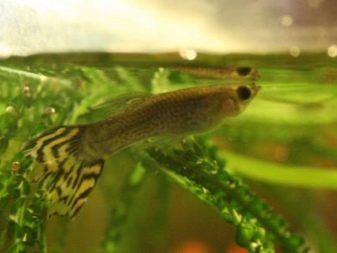
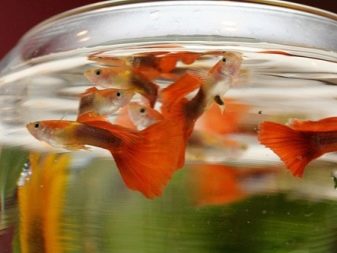
Immobility
Another common problem is that the gupeshka is at the bottom, breathing heavily and looking exhausted. There are many reasons for this phenomenon; one can try to consistently improve the situation in all of the proposed areas. In some cases, the symptom is genetically determined, sometimes it is directly related to old age, because even a healthy fish dies sooner or later.
A somewhat unusual reason is that in this position, the female rests from the courtship of the male. If the reason lies precisely in this, in a day or two she will feel better and she will begin to swim again. For this reason, experts do not advise keeping populations predominantly in the direction of males, as they are able to tire a girlfriend to death, which is not an exaggeration.
Whatever the problem is caused, long "rest" of fish at the bottom in the absence of appetite and visible suffering usually indicates the severity of the situation.
As a rule, if there are no improvements within two days, experienced aquarists prefer to kill the pet so that it does not suffer.
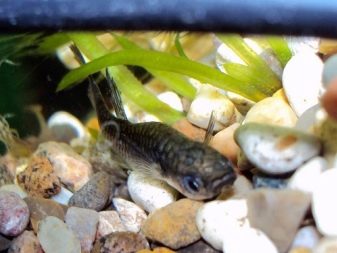
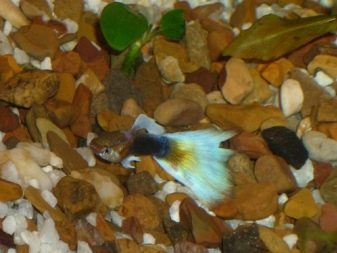
Review Reviews
Even among beginner aquarists, most people are well aware of what kind of guppy fish and how to care for it. If you are one hundred percent new to this business, listening to reviews will not hurt. Public opinion says that this is one of the most versatile aquarium fish, which is perfect for starting in the aquarium, as well as for breeding by enthusiastic professionals. The small size of such pets allows them to be kept in relatively tight containers, it is very easy to breed, and the “gupeshka” looks beautiful and pleases the eye with its activity.
May seem paradoxical but beginners are usually advised to abandon the most striking selection guppies in favor of a little more faded, close to natural. The fact is that selection is aimed at breeding individuals with attractive external data, while adaptability and immunity are ignored. For this reason, the most colorful varieties are characterized by increased requirements for the conditions of detention and may simply not survive in an inexperienced host.
Having made the seemingly illogical choice in favor of faded fish, you will have an increased chance of success and are more likely to linger in the aquarium for a long time.
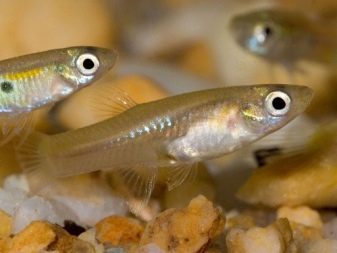
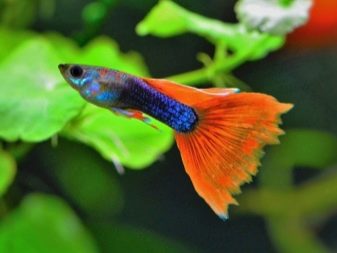
Tips
It’s worth considering a few simple tips that are not always obvious to beginners regarding how to contain "gupeshka".
- Do not test fish for survival. There are legends about the unpretentiousness of this type of aquarium inhabitants, in some cases they survive almost in a bottle, without vegetation, aeration, filtration, or even normal feeding. The instincts of these living organisms are so strong that even in such conditions they try to give offspring, that is, they imitate normal life activity. Nevertheless, from the owner’s side this is a real mockery, and from an aesthetic point of view such an “aquarium” does not look beautiful.
When deciding to join aquarists, be so kind as to comply with the minimum requirements; guppies do not have so many.
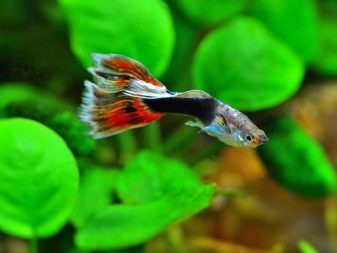
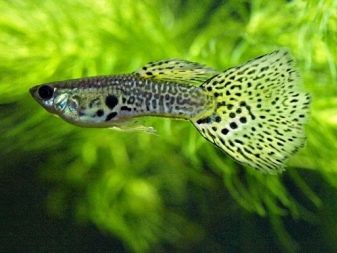
- Some owners do not consider it necessary to place the female during pregnancy in a separate pond, which is not entirely correct. Firstly, she has already become pregnant, so she should be protected from the intrusive attention of males, whose instincts from this fact do not become less pronounced. Secondly, her diet should be more nutritious, and it is also completely unacceptable that she receive less food due to the greed of other aquarium inhabitants. Thirdly, any adult individual is able to gobble up newborn babies, so the less outsiders are in the spawning grounds, the better for the young.

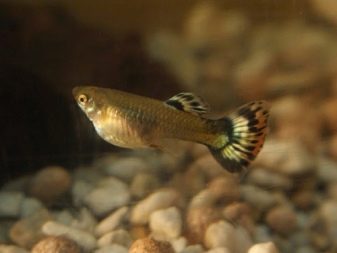
- Guppies, like people, sleep to restore the body. Most often this happens at night, because the owner must turn off the lights every night, allowing the pets to relax. At the same time, guppies do not have an internal clock, for them the night falls when it gets dark, and the schedule that has moved out usually does not become a problem. During sleep, the fish become almost motionless, they only jerk reflexively to stabilize their position and stay closer to the bottom.
Pregnant females get tired more often, they sometimes rest this way even during the day, but if the male or his girlfriend does not behave this way, this may be an indicator of the presence of health problems.
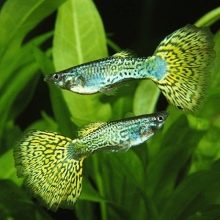
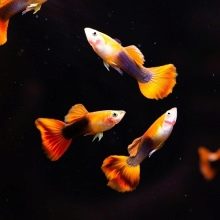
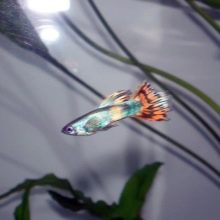
You can learn more about how to care for guppies.
